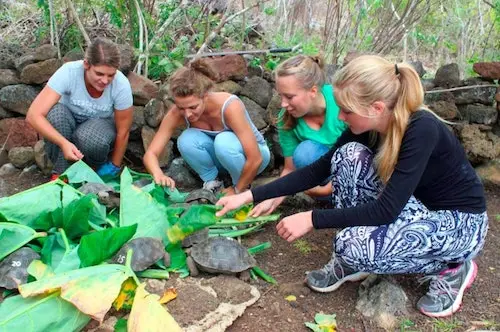Travel insights from Latin America
How to Plan a More Eco-Friendly Educational Tour

These conservation and protection projects are certified and vetted and can include protecting habitats for birds in Guatemala and reforestation projects in the Brazilian Amazon. You will then receive a certificate, showing how much you have donated.
Of course, a responsible travel operator should include this in your package but we recommend supplementing this to ensure that you overcompensate for CO2 emissions.
Tip: involve students in this process, encouraging them to calculate and donate to these projects themselves.
Tip 3: Choose a destination close to home
One of the easiest ways to reduce the impact on the environment is to choose a destination to a neighboring country.
Of course, choosing a destination within your own country and negating the need to fly, would further reduce carbon emissions.
This brings forward the travel conundrum – do the benefits of travel outweigh the inevitable environmental damage? The only way to truly know this is to plan and measure, to the best of your ability, the positive impacts of the trip vs the negative environmental impacts.
Tip: draw up a theory of change to determine what you want your students to gain from the trip and whether travel is required for this desired change.
Tip 4: Choose the right airline
The way airlines operate can severely affect their performance in terms of carbon emissions.
But how do you know which ones are environmentally conscious? Alternative Airlines, a search engine for international flights, gives you essential information on more eco-friendly airlines.
You’ll discover that Delta is investing heavily in its carbon offsetting and has committed to removing all plastic from its planes. And, in 2019 Etihad Airways powered a commercial flight using a mix of jet and biofuel – material used from the Salicornia plant.
Also, look out for those airlines that have signed up for the CORSIA (Carbon Offsetting and Reduction Scheme for International Aviation) agreement. This obliges airlines to report their carbon emissions and offset any increase in their carbon emissions from 2020.
Tip: try to get a non-stop flight as this will lower the carbon emissions produced from landing, taxing around another airport and then taking off again.
Tip 5: Eco-friendly internet searching
Did you know you can help with the global reforestation effort by just choosing the way you search on the internet?
Ecosia uses the profits generated by you using its search engine to plant trees across the world. In fact, they claim that for approximately every 45 searches you make, they plant 1 tree.
Their internal carbon footprint is incredibly low too as they run on 100 per cent renewable energy.
Tip: encourage your university to add Ecosia to its network, in turn joining others from around the world as seen here on their Campus Campaign.
Tip 6: Consume responsibly

Students eating typical Colombian lunch wrapped in banana leaf
One of the easiest ways to lower carbon emissions is to eat and buy from responsible local suppliers and manage your food waste.
This UN Food and Agriculture Organization report says that if food waste were a country it would be the third highest emitter of greenhouse gases in the world. Keeping this to a minimum will not only lower your carbon footprint during the trip but also set a great example to your students.
Tip: enquire about your hotel’s food waste management process or ask your local operator to choose only locally-run restaurants with local produce. And visit local markets during your trip!
Tip 7: Choose eco-friendly accommodation
Again, this is something a great local operator should help you with. But if you are booking accommodation yourself, the best way to ensure eco-friendly stays is to look for international certifications.
These will prove your host has gone through rigorous assessments to certify its environmental and social commitments.
Look out for: Rainforest Alliance, B Corporation, Green Globe and Green Key. Alternatively, you could contact the local tourism board to inquire about the most eco-conscious hotels.
Top tip: book a hotel with Staze and they will offset the carbon emissions of your booking for FREE.
Tip 8: Reduce water waste
We have known that plastic is bad for the environment. In fact, glass, tins and any container that have to be made and then destroyed or recycled have a big impact on the environment.
To solve this, insist that students bring their own refillable water bottles to either fill up from a clean water supply.
An environmentally-conscious operator should supply drinking water throughout the trip in order to drastically reduce carbon emissions from unnecessary drink purchases.
Tip: to really minimize the environmental damage, choose a responsibly made bottle like the US-based brand – Nalgene or Liberty Bottles – both of which are BPA-free and use ethically-sourced materials to make their bottles.
Tip 9: Use public transport, cycle & walk places
Try to avoid using cars, taxis or especially internal flights when on a trip. Look for trains and public buses, whose carbon emissions are much less and often the journey is more fun.
Even better, choose a cycling journey or walk as much as possible.
At Kagumu we run a selection of expeditions for schools that include multi-day walks, a super low-carbon way of travel!
Get in touch with our team to start planning your school trip.
As teachers and students demand more educational tours that limit damage to the planet, we look at how to create a more environmentally sustainable trip.
From responsible tour operators to carbon compensation. And from progressive airlines to internet searches to plant trees, we share 10 tips to travel in a more eco-friendly manner.
Top 1: Choose a responsible local operator
An easy way to limite environmental damage while traveling is choose a travel operator conscious of its impact.
A responsible operator should offer carbon compensated travel. This means they have measured, reduced and compensated the CO2 emissions from flights, on-ground transport, and hotels.
Everyone knows flights continue to climate change and emit lots of carbon. But other services you use during a trip also contributes to your carbon footprint.
It’s often difficult to know the most eco-friendly services – restaurants, hotels, means of transport – when visiting a new country. So working with a conscious and experienced local operator is vitally important.
Tip: request information on the internal operations of a company to assess its commitment to environmental sustainability. You can read Kagumu’s commitment to measuring, reducing and offsetting emissions by clicking here.
Tip 2: Compensate your carbon


Tomorrow’s air is a carbon capture option for travellers.
One of the easiest ways to offset your flight’s environmental damage is to calculate the tonnes of CO2 emitted and then donate the equivalent amount to a certified reforestation or clean energy project.
For example, if you have a return flight in economy class from London to Medellin with a stopover in Bogota, simply enter your details in South Pole’s calculator.
You will see that for one person the amount of carbon emitted is 3.159 tonnes. You can then go to Stand For Trees and choose a project to donate 3.159 tonnes of carbon credit.
These conservation and protection projects are certified and vetted and can include protecting habitats for birds in Guatemala and reforestation projects in the Brazilian Amazon. You will then receive a certificate, showing how much you have donated.
Of course, a responsible travel operator should include this in your package but we recommend supplementing this to ensure that you overcompensate for CO2 emissions.
Tip: involve students in this process, encouraging them to calculate and donate to these projects themselves.
Tip 3: Choose a destination close to home
One of the easiest ways to reduce the impact on the environment is to choose a destination to a neighboring country.
Of course, choosing a destination within your own country and negating the need to fly, would further reduce carbon emissions.
This brings forward the travel conundrum – do the benefits of travel outweigh the inevitable environmental damage? The only way to truly know this is to plan and measure, to the best of your ability, the positive impacts of the trip vs the negative environmental impacts.
Tip: draw up a theory of change to determine what you want your students to gain from the trip and whether travel is required for this desired change.
Tip 4: Choose the right airline
The way airlines operate can severely affect their performance in terms of carbon emissions.
But how do you know which ones are environmentally conscious? Alternative Airlines, a search engine for international flights, gives you essential information on more eco-friendly airlines.
You’ll discover that Delta is investing heavily in its carbon offsetting and has committed to removing all plastic from its planes. And, in 2019 Etihad Airways powered a commercial flight using a mix of jet and biofuel – material used from the Salicornia plant.
Also, look out for those airlines that have signed up for the CORSIA (Carbon Offsetting and Reduction Scheme for International Aviation) agreement. This obliges airlines to report their carbon emissions and offset any increase in their carbon emissions from 2020.
Tip: try to get a non-stop flight as this will lower the carbon emissions produced from landing, taxing around another airport and then taking off again.
Tip 5: Eco-friendly internet searching
Did you know you can help with the global reforestation effort by just choosing the way you search on the internet?
Ecosia uses the profits generated by you using its search engine to plant trees across the world. In fact, they claim that for approximately every 45 searches you make, they plant 1 tree.
Their internal carbon footprint is incredibly low too as they run on 100 per cent renewable energy.
Tip: encourage your university to add Ecosia to its network, in turn joining others from around the world as seen here on their Campus Campaign.
Tip 6: Consume responsibly



Students eating typical Colombian lunch wrapped in banana leaf
One of the easiest ways to lower carbon emissions is to eat and buy from responsible local suppliers and manage your food waste.
This UN Food and Agriculture Organization report says that if food waste were a country it would be the third highest emitter of greenhouse gases in the world. Keeping this to a minimum will not only lower your carbon footprint during the trip but also set a great example to your students.
Tip: enquire about your hotel’s food waste management process or ask your local operator to choose only locally-run restaurants with local produce. And visit local markets during your trip!
Tip 7: Choose eco-friendly accommodation
Again, this is something a great local operator should help you with. But if you are booking accommodation yourself, the best way to ensure eco-friendly stays is to look for international certifications.
These will prove your host has gone through rigorous assessments to certify its environmental and social commitments.
Look out for: Rainforest Alliance, B Corporation, Green Globe and Green Key. Alternatively, you could contact the local tourism board to inquire about the most eco-conscious hotels.
Top tip: book a hotel with Staze and they will offset the carbon emissions of your booking for FREE.
Tip 8: Reduce water waste
We have known that plastic is bad for the environment. In fact, glass, tins and any container that have to be made and then destroyed or recycled have a big impact on the environment.
To solve this, insist that students bring their own refillable water bottles to either fill up from a clean water supply.
An environmentally-conscious operator should supply drinking water throughout the trip in order to drastically reduce carbon emissions from unnecessary drink purchases.
Tip: to really minimize the environmental damage, choose a responsibly made bottle like the US-based brand – Nalgene or Liberty Bottles – both of which are BPA-free and use ethically-sourced materials to make their bottles.
Tip 9: Use public transport, cycle & walk places
Try to avoid using cars, taxis or especially internal flights when on a trip. Look for trains and public buses, whose carbon emissions are much less and often the journey is more fun.
Even better, choose a cycling journey or walk as much as possible.
At Kagumu we run a selection of expeditions for schools that include multi-day walks, a super low-carbon way of travel!
Get in touch with our team to start planning your school trip.
